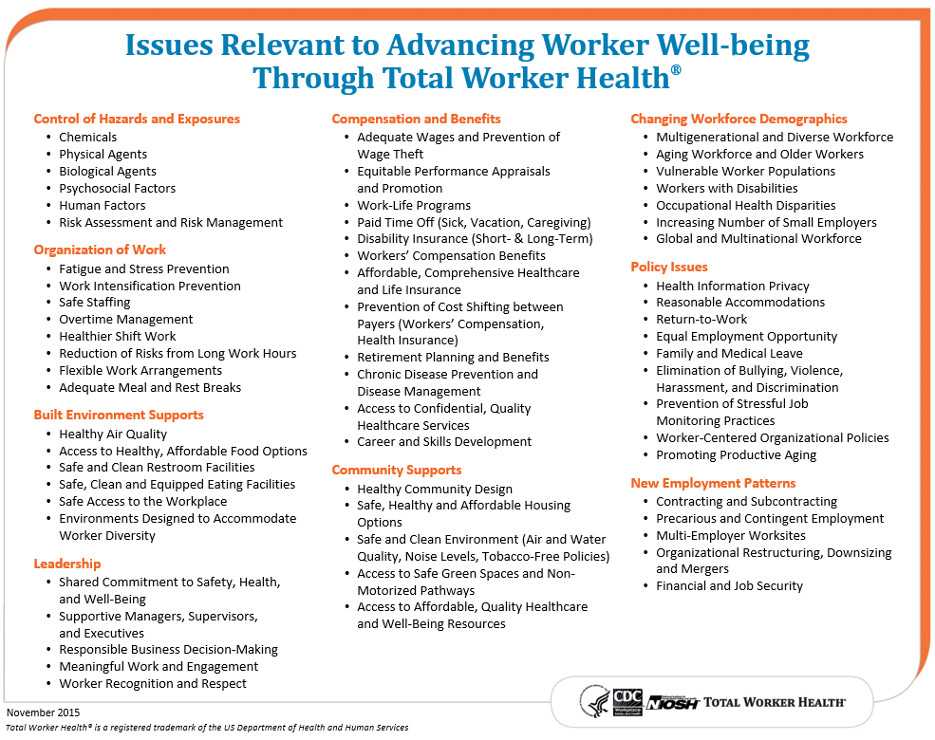TOTAL WORKER HEALTH

Program Description
NIOSH Total Worker Health Website
Total Worker Health (TWH) is defined as policies, programs, and practices that integrate protection from work-related safety and health hazards with promotion of injury and illness prevention efforts to advance worker well-being.
Traditional occupational safety and health protection programs have primarily concentrated on ensuring that work is safe and that workers are protected from the harms that arise from work itself. TWH builds on this approach through the recognition that work is a social determinant of health; job-related factors such as wages, hours of work, workload and stress levels, interactions with coworkers, and access to leave and healthful workplaces all can have an important impact on the well-being of workers, their families, and their communities. TWH explores opportunities to not only protect workers, but also advance their health and well-being by targeting the conditions of work. Scientific evidence now supports what many safety and health professionals, as well as workers themselves, have long suspected – that risk factors in the workplace can contribute to health problems previously considered unrelated to work. For example, there are work-related risk factors for abnormal weight fluctuations 1, 2, sleep disorders3, cardiovascular disease4, depression5, 6, 7, and other health conditions. In recognition of these emerging relationships, the TWH approach focuses on how environmental, workplace factors can both mitigate and enhance overall worker health beyond traditional OSH concerns.
In June 2011, NIOSH launched the Total Worker Health® (TWH) Program as an evolution of the NIOSH Steps to a Healthier U.S. Workforce and the NIOSH WorkLife Initiatives. The TWH Program supports the development and adoption of ground-breaking research and best practices of integrative approaches that integrate protection from work-related safety and health hazards with injury and illness prevention efforts to advance worker well-being. The original scientific rationale for expanding research on the benefits of integrated programs to improve worker health and workplace safety was published in a research compendium of three seminal papers on the science and practice of integrating health protection and health promotion, The NIOSH Total Worker Health Program: Seminal Research Papers 2012 .
The TWH Program includes an intramural component and an extramural component, comprised of four Centers of Excellence for Total Worker Health . Both of these components conduct research on the integration of health protection and efforts to more broadly advance worker well-being; communication of current knowledge, successful approaches, challenges, and advocacy of the concepts and practices of Total Worker Health to our partners and stakeholders.
In November 2012, further evidence was presented by the four NIOSH-funded Centers of Excellence for Total Worker Health at the first Symposium on Total Worker Health® sponsored by the University of Iowa's Healthier Workforce Center of Excellence .
The "Issues Relevant to Total Worker Health" graphic below is an at-a-glance visual of issues relevant to integrating occupational safety and health protection with health promotion. The lists below are not meant to be exhaustive, but, rather they illustrate the breadth of issues related to work that has the potential to impact health and should be considered as strategies are developed for the integration of health protection and health promotion activities.
The following graphic “Issues Relevant to Advancing Worker Well-being Through Total Worker Health®” illustrates a wide-ranging list of issues that are relevant to advancing worker well-being through a Total Worker Health approach. The list of issues relevant to Total Worker Health was revised, retitled and published in November 2015 with input from stakeholders. This updated list reflects an expanded focus for TWH that recognizes that new technologies, new working conditions, and new emerging forms of employment present new risks to worker safety, health and well-being. Understanding and reducing those risks are important elements of TWH. Additionally, this expanded focus recognizes that there are linkages between health conditions that may not arise from work but that can be adversely affected by work. A Total Worker Health approach advocates for the integration of all organizational policies, programs and practices that contribute to worker safety, health and well-being, including those relevant to the control of hazards and exposures, the organization of work, compensation and benefits, built environment supports, leadership, changing workforce demographics, policy issues, and community supports.
Issues Relevant to a Total Worker Health® Perspective*

*Issues in these lists are for illustrative purposes, are not meant to be exhaustive nor do they necessarily reflect equivalent importance.
†Health Insurance Portability and Accountability Act
Updated: August 2013
Download a PDF of this graphic
Interventions consistent with TWH include but are not limited to:
- Provision of mandated respiratory protection programs that simultaneously and comprehensively address and provide supports for tobacco cessation.
- Integrated ergonomic consultations that also discuss joint health, arthritis prevention, and management strategies.
- Regularly scheduled, joint meetings of safety, occupational health and health promotion leadership and staff to include combining the functions of safety, health, and/or sustainability committees into one entity, either intermittently or permanently.
- Development of stress management efforts that first seek to diminish workplace stressors, and only then work on building worker resiliency.
- Implementation of training and prevention programs that counter hazards and risks faced by workers both on and off the job. Topics could include falls prevention, motor vehicle safety, first aid, hearing conservation, stretching/flexibility, back safety/lifting safety, eye protection, safer work with chemicals, and weight management.
- Provision of onsite, comprehensive workplace screenings for work and non-work related health risks.
- Exploration of models that combine occupational health services with workplace primary care.
- Full integration of: traditional safety programs, occupational health clinics, behavioral health, health promotion programs, coaching, Employee Assistance Programs (EAP), nutrition, disability and workers compensation through strategic alignment, joint reporting structures or common funding streams.
Previous Page Next Page: Economic Factors
- Page last reviewed: April 16, 2013
- Page last updated: October 8, 2015
- Content source:
- National Institute for Occupational Safety and Health Office of the Director


 ShareCompartir
ShareCompartir